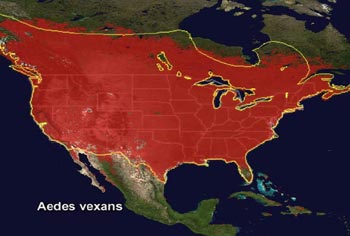NASA researchers developing tools to help track and predict West Nile Virus

Satellites can "track" mosquitoes by focusing on geographical regions of the species most favorable conditions. Conventional techniques in mosquito tracking have already produced maps showing these favorable regions. Side by side, recent satellite data matches the published mosquito habitats almost identically. <br> <br>Habitats determined by satellite data are shown in red. Mosquito distribution maps determined by means other than satellite surveillance are outlined in yellow. The four species represented here have tested positive for West Nile Virus in each of the past four years. They are: Culex salinarius, Culex pipiens, Culex restuans, and Aedes vexans. Data source: International Research Partnership for Infectious Diseases (INTREPID).
NASA researchers are conducting Earth Science research that may one day allow public health officials to better track and predict the spread of West Nile Virus. NASA’s goal is to provide people on the front lines of public health with innovative technologies, data and a unique vantage point from space through satellites, all tailored into useful tools and databases for streamlining efforts to combat the disease.
NASA’s Public Health Applications Program focuses the results of research occurring at different NASA centers. The program is designed to eventually supply public health agencies with access to NASA’s cutting-edge capabilities in formats they can use to better understand how and where West Nile Virus spreads, focus resources and stave off the disease more efficiently.
“The goal of the program is to extend the benefits of NASA’s investments in Earth system science, technology and data toward public-health decision making and practice,” said Robert Venezia, program manager at NASA Headquarters, Washington.
West Nile Virus, first reported in the United States in 1999, causes flu-like symptoms that may lead to fatal encephalitis in people with compromised immune systems, like the elderly. Though not yet proven, scientists believe the disease may be spread across the country by infected birds traveling along their migration routes. Mosquitoes that act as a vector carry the virus and pass it on when feeding on hosts like birds, livestock, other animals and people.
Based on what is known about the disease, NASA centers, including the Goddard Space Flight Center, Greenbelt, Md., and Ames Research Center in Moffett Field, Calif., are researching methods to identify environmental indicators from data acquired on NASA Earth Observing Systems, packaged in ways that highlight factors relevant to West Nile Virus transmission.
For example, NASA’s Healthy Planet program is researching approaches to publicly disseminate information from NASA Earth-observing satellites and data archives, scientific research and communications networks.
Healthy Planet has helped Pennsylvania implement the PA West Nile Virus Surveillance System (PAWNVSS), a state-wide Geographic Information System (GIS) mapping program that will verify and validate the use of NASA weather, climate and land-use data to identify areas ripe for mosquitoes and West Nile Virus. The database contains information about dead bird findings, and human health reports of West Nile Virus. Pennsylvania agencies are currently using the PAWNVSS system to make daily decisions on the best places and times to spray for mosquitoes.
“NASA’s help has allowed us to understand climate change and to predict the beginning and end of the mosquito season across Pennsylvania,” said Eric Conrad, Deputy Secretary for Field Operation at the Pennsylvania Department of Environmental Protection. “This information allows us to know when to start our mosquito-surveillance season and when to consider the season over.”
Another NASA program, called the International Research Partnership for Infectious Diseases (INTREPID), is developing information products and databases derived from satellite data to show nation-wide temperatures, distributions of vegetation, bird migration routes and areas pinpointing reported cases. The combined data help scientists predict disease outbreaks by showing when and where habitats are suitable for the insects to thrive and where the disease appears to be spreading.
NASA’s Center for Health Applications of Aerospace Related Technologies is evaluating how NASA technologies like remote sensing and GIS can be used to locate habitats in California’s Sacramento valley with favorable conditions for both birds and mosquitoes. The project specifically seeks to track encephalitis, caused by a virus very similar to West Nile Virus that also primarily infects birds through mosquito vectors. These technologies may then be combined with surveys of infected birds and bird migration paths, obtained from radio transmitters placed on birds, to create temporal and spatial risk maps that may help public health personnel.
These examples from the Public Health Applications Program typify how NASA Earth Science research results are being evaluated for future use in providing decision-support for dealing with a broad range of diseases.
These efforts are in conjunction with federal, state and local public health agency initiatives. NASA is planning a joint public health and Earth Science peer review with agencies responsible for addressing national concerns on West Nile Virus. These agencies include the Centers for Disease Control and Prevention, National Institutes of Health, Environmental Protection Agency, United States Geological Survey and state health departments.
Media Contact
More Information:
http://www.gsfc.nasa.gov/topstory/20020828phap.htmlAll latest news from the category: Health and Medicine
This subject area encompasses research and studies in the field of human medicine.
Among the wide-ranging list of topics covered here are anesthesiology, anatomy, surgery, human genetics, hygiene and environmental medicine, internal medicine, neurology, pharmacology, physiology, urology and dental medicine.
Newest articles

Durable, Efficient, Sustainable: The Rise of Cerium Oxide Thermal Switches
Groundbreaking cerium oxide-based thermal switches achieve remarkable performance, transforming heat flow control with sustainable and efficient technology. Cerium Oxide-Based Thermal Switches Revolutionize Heat Flow Control Thermal switches, which electrically control…

How Industrial Robots are Reducing Emissions in Global Manufacturing
A new study explores the intersection of industrial automation and environmental sustainability, focusing on the role of industrial robots in reducing the carbon intensity of manufacturing exports. The research demonstrates…

Patients Can Heal Through Precise, Personalized Bioceramic Grafts
A recent review is transforming the landscape of craniomaxillofacial bone regeneration with the introduction of personalized bioceramic grafts. This pioneering research explores the fabrication and clinical potential of synthetic grafts…



